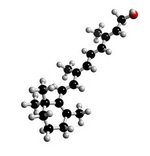|
Vitamin A – The Retinoids - Necessary For Good Eye HealthVitamin A plays a key role in vision, and a deficiency in this vitamin can result in the destruction of vision. The vitamin has other roles as well, such as growth, reproduction, cell differentiation, functioning of the immune system, helping to maintain healthy bones, skin and mucous membranes.
Vitamin A Molecule
There are three active forms of this vitamin used by the body which are known as a group as the retinoids. These three forms are retinol, retinal, and retinoic acid, and of the three retinol plays the key role in the body. There are also the carotenoids which are precursors of the vitamin. In healthy individuals the liver will store 90% of the vitamin in the liver; the rest will be stored in adipose (fat) tissue, the lungs and kidneys.
Since retinol is the form of the vitamin that plays the most key role in the body, it is measured in a unit called retinol activity equivalents (RAE), which is considered a more accurate unit of measure than the outdated international units (IU). For most Americans the amount of the vitamin taken in is adequate and there are adequate stores in the liver. The recommended dietary allowance (RDA) has been given for males aged 14 years and older as 900 micrograms RAE, for females aged 14 years and older the RDA is 700 micrograms RAE, and for women who are pregnant should consume 770 micrograms RAE and lactating women should consume 1,300 micrograms RAE. However, although IU is an outdated unit, this is still how these units are listed on food nutrition panels; therefore, the recommended IU for vitamin A is a daily value = 5000 IU. A food is considered a good source if it contains 10-19% of the daily value and a high source if it contains 20% of the daily value, so if a food contains 500-950 IU it is a good food source and if it contains 1000 IU it is considered a high food source. The amount of the vitamin is given as a percent on the nutrition facts panel. What Are Some Natural Sources Of Vitamin A? 

The dietary sources of vitamin A consist of half from animal sources and half from the vitamin precursor carotenoids especially in the form beta-carotene which are the fruit and vegetable sources. Retinoids are found naturally only in animal sources, with liver and fish liver oils (such as cod liver oil) being the top sources, with milk fats in the form of butter, whole milk, and other dairy products following close behind. The best source of carotenoids are dark green and yellow orange vegetables such as carrots, spinach, broccoli, squash, sweet potatoes, and some orange colored fruits such as cantaloupes, peaches, apricots, and mangos. Vitamin A Deficiency Vitamin A deficiency is the leading cause of blindness in the third world, but rare in the developed world, it also leads to leads to bone deformities and retards general growth and development. One of the early symptoms of a deficiency is night blindness leading eventually to total blindness if not treated. Although rare in places such as the North American continent, there are certain groups at risk such as premature infants whose ability to store the vitamin in their liver is not well developed yet, and poverty causes a marginal deficiency because the diets of impoverished peoples is low in the vitamin, and with our increasingly poor economy which is pushing more and more families and individuals into poverty, we may well see the vitamin deficiency increase. Another vulnerable group is those that suffer from alcoholism since their livers are damaged and incapable of storing the vitamin properly. Other individuals who may develop a deficiency over time are those with Crohn’s disease, cystic fibrosis, celiac disease, chronic diarrhea, pancreatic insufficiency and other malabsorption syndromes related to fat absorption, since the vitamin is a fat soluble vitamin are also vulnerable. What Are The Symptoms Of Too Much Vitamin A? Some of the symptoms of vitamin toxicity are fatigue, vomiting, abdominal pain, bone and joint pain, loss of appetite, skin disorders, blurred or double vision, headache, and liver damage leading to jaundice.
For other information on nutrition some great references are: • Nutrition – Fourth Edition by Paul Insel, Don Ross, Kimberley McMahon, and Melissa Bernstein
Vitamins
|






